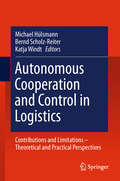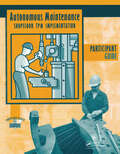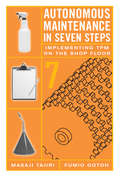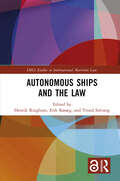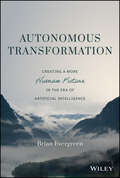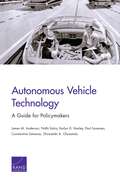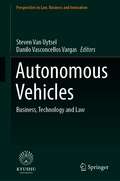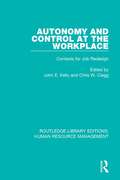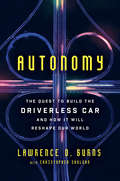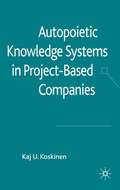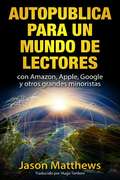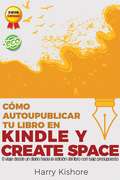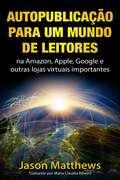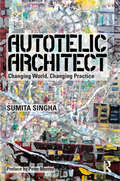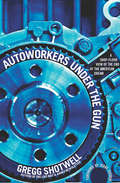- Table View
- List View
Autonomous Cooperation and Control in Logistics: Contributions and Limitations - Theoretical and Practical Perspectives
by Michael Hülsmann Bernd Scholz-Reiter Katja WindtMany new technologies - like RFID, GPS, and sensor networks - that dominate innovative developments in logistics are based on the idea of autonomous cooperation and control. This self-organisational concept describes "...processes of decentralized decision-making in heterarchical structures. It presumes interacting elements in non-deterministic systems, which possess the capability and possibility to render decisions. The objective of autonomous cooperation and control is the achievement of increased robustness and positive emergence of the total system due to distributed and flexible coping with dynamics and complexity" (Hülsmann & Windt, 2007). In order to underlie these technology-driven developments with a fundamental theoretical foundation this edited volume asks for contributions and limitations of applying the principles of autonomous cooperation and control to logistics processes and systems. It intends to identify, describe, and explain - in the context of production and distribution logistics - the effects on performance and robustness, the enablers and impediments for the feasibility, the essential cause-effect-relations, etc. of concepts, methods, technologies, and routines of autonomous cooperation and control in logistics. Therefore, the analyses collected in this edited volume aim to develop a framework for finding the optimal degree as well as the upper and lower boundaries of autonomous cooperation and control of logistics processes from the different perspectives of production technology, electronics and communication engineering, informatics and mathematics, as well as management sciences and economics.
Autonomous Maintenance Video Participants Guide (ISSN)
by Press ProductivityThis is the Participant Guide to support team leaders in implementing an autonomous maintenance team. This is usually sold with Autonomous Maintenance: Shopfloor TPM Implementation. This is for extra copies.
Autonomous Maintenance in Seven Steps: Implementing TPM on the Shop Floor
by Fumio GotohAutonomous maintenance is an especially important pillar of Total Productive Maintenance (TPM) because it enlists the intelligence and skills of the people who are most familiar with factory machines-- equipment operators. Operators learn the maintenance skills they need to know through a seven-step autonomous maintenance program. Most companies in the West stop after implementing the first few steps and never realize the full benefits of autonomous maintenance. This book contains comprehensive coverage of all seven steps--not just the first three or four.It includes:An overview of autonomous maintenance features and checklists for step audits to certify team achievement at each AM step.TPM basics such as the six big losses, overall equipment effectiveness (OEE), causes of losses, and six major TPM activities.An implementation plan for TPM and five countermeasures for achieving zero breakdowns.Useful guidelines and case studies in applying AM to manual work such as assembly, inspection, and material handling.Integrates examples from Toyota, Asai Glass, Bridgestone, Hitachi, and other top companies.By treating machines as partners and taking responsibility for them, you get machines that you can rely on and help maintain an energized and responsive workplace. For companies that are serious about taking autonomous maintenance beyond mere cleaning programs, this is an essential sourcebook and implementation support.
Autonomous Ships and the Law (ISSN)
by Henrik Ringbom Erik Røsæg Trond SolvangInterest in autonomous ships has grown exponentially over the past few years. Whereas a few years ago, the prospect of unmanned and autonomous vessels sailing on the seas was considered unrealistic, the debate now centers on when and in what format and pace the development will take place.Law has a key role to play in this development and legal obstacles are often singled out as principal barriers to the rapid introduction of new technologies in shipping. Within a few years, autonomous ships have turned from a non-issue to one of the main regulatory topics being addressed by the International Maritime Organization. However, the regulatory discussion is still in its infancy, and while many new questions have been raised, few answers have been provided to them to date.Increased automation of tasks that have traditionally been undertaken by ships' crews raises interesting legal questions across the whole spectrum of maritime law. The first of its kind, this book explores the issue of autonomous ships from a wide range of legal perspectives, including both private law and public law at international and national level, making available cutting-edge research which will be of significant interest to researchers in maritime law.Chapter 3 of this book is freely available as a downloadable Open Access PDF at http://www.taylorfrancis.com under a Creative Commons Attribution-Non Commercial (CC-BY-NC) 4.0 license.
Autonomous State
by Dimitry AnastakisAutonomous State provides the first detailed examination of the Canadian auto industry, the country's most important economic sector, in the post-war period. In this engrossing book, Dimitry Anastakis chronicles the industry's evolution from the 1973 OPEC embargo to the 1989 Canada-US Free Trade Agreement and looks at its effects on public policy, diplomacy, business enterprise, workers, consumers, and firms.Using an immense array of archival sources, and interviews with some of the key actors in the events, Anastakis examines a fascinating array of topics in recent auto industry and Canadian business and economic history: the impact of new safety, emissions, and fuel economy regulations on the Canadian sector and consumers, the first Chrysler bailout of 1980, the curious life and death of the 1965 Canada-US auto pact, the 'invasion' of Japanese imports and transplant operations, and the end of aggressive auto policy-making with the coming of free trade.More than just an examination of the auto industry, the book provides a rethinking of Canada's tumultuous post-OPEC political and economic evolution, helping to explain the current tribulations of the global auto sector and Canada's place within it.
Autonomous Transformation: Creating a More Human Future in the Era of Artificial Intelligence
by Brian EvergreenFrom technologist and strategist Brian Evergreen, a bold new agenda for the role of organizational leaders in creating a more human future with technology Social good initiatives are incompatible with the current network of systems that make up and support the private and public sectors. Millions of dollars have been invested in bringing leaders together from organizations around the world to design solutions for global challenges such as the climate crisis, child labor, racism, war, and many more. Despite executive buy-in, alignment of core capabilities and resources, passionate leadership, and well-designed strategies, these initiatives inevitably fail (with a few, notable exceptions). The dawn of the Internet ignited a global redesign and rebuild of the interlocking systems that make up and support the private and public sectors today. The era of Digital Transformation extended this further through the adoption of cloud technologies and distributed computing. With a recent wave of technological advancements, organizations have arrived at another global redesign and rebuilding of the network of systems that make up society: Autonomous Transformation, revealing an opportunity for leaders to create Profitable Good through systemic design in combination with emerging autonomous technologies and surprising and remarkable partnerships. Autonomous Transformation provides a blueprint for leaders and managers who have aspired or attempted to harness artificial intelligence and its adjacent technologies for the betterment of their organization and the world, weaving strategy, business, economics, systemic design, and philosophy into four actionable steps with accompanying frameworks: Clear the Digital Fog See the Systems Choose a Problem Future Design Inevitability
Autonomous Vehicle Technology: A Guide for Policymakers
by James M. Anderson Constantine Samaras Paul Sorensen Nidhi Kalra Karlyn D. Stanley Oluwatobi A. OluwatolaThe automotive industry appears close to substantial change engendered by "self-driving" technologies. This technology offers the possibility of significant benefits to social welfare--saving lives; reducing crashes, congestion, fuel consumption, and pollution; increasing mobility for the disabled; and ultimately improving land use. This report is intended as a guide for state and federal policymakers on the many issues that this technology raises.
Autonomous Vehicles: Business, Technology and Law (Perspectives in Law, Business and Innovation)
by Steven Van Uytsel Danilo Vasconcellos VargasThis edited book aims to address challenges facing the deployment of autonomous vehicles. Autonomous vehicles were predicted to hit the road by 2017. Even though a high degree of automation may have been achieved, vehicles that can drive autonomously under all circumstances are not yet commercially available, and the predictions have been adjusted. Now, experts even say that we are still decades away from fully autonomous vehicles. In this volume, the authors form a multidisciplinary team of experts to discuss some of the reasons behind this delay. The focus is on three areas: business, technology, and law. The authors discuss how the traditional car manufacturers have to devote numerous resources to the development of a new business model, in which the sole manufacturing of vehicles may no longer be sufficient. In addition, the book seeks to introduce how technological challenges are creating a shift toward connected autonomous vehicles. Further, it provides insight into how regulators are responding to the insufficiently tested technology and how lawyers try to answer the liability question for accidents with these autonomous vehicles.
Autonomous Vehicles: The Rubber Hits the Road...but When?
by Allison M. Ciechanover William R. Kerr Jeff Huizinga James PalanoAutonomous vehicles have enormous implications for business and society. But, despite the headline-laden attention paid to the technology, there remain more questions than answers. Students will learn about the complex industry and have explicit discussions about the factors influencing development and commercialization and how various stakeholders might respond. They will also be put in the shoes of decision-makers looking for signals that might help them prepare for the disruptive change ahead.
Autonomous and Integrated Parking and Transportation Services
by Amalendu ChatterjeeIn this book, the author outlines a Robust Web Parking, Truck and Transportation Portal (RWPTTP) for integrating parking and transportation services – a revolutionary approach in contrast to incremental change for managing traffic congestion. Autonomous vehicle technology, artificial intelligence, internet of things (IOT), and other interconnected hardware and software tools will assist autonomous parking and transportation services and provide next-century infrastructure for consolidated transportation customer services. The book highlights currently available autonomous parking and transportation technologies, and the development of an integrated and intelligent transportation service/system (IITS) platform, with specific use of technologies to reconfigure the transportation industry. The author also suggests many regulatory and policy changes to simplify data collection, traffic operation, introduction of a duplicate transportation system using light rail (LRs) and high speed rail (SPRs), and redistribution of parking spaces along such routes, using renewable energy.
Autonomy and Control at the Workplace: Contexts for Job Redesign (Routledge Library Editions: Human Resource Management)
by John E. KellyThis book, first published in 1982, aims to re-examine the phenomenon of job redesign in a series of different but related contexts by including accounts, often using case study material, from people trained in a range of social science disciplines utilising different frames of reference. Thus job redesign is considered in relation to social policy, payment systems, collecting bargaining arrangements and trade unions, new technology, the process of change, organisational structures and functions, information and control systems, and the whole issue of emancipation at work. This title will be of interest to students of business studies and human resource management.
Autonomy and Unmanned Vehicles: Augmented Reactive Mission And Motion Planning Architecture (Cognitive Science And Technology Ser.)
by Somaiyeh MahmoudZadeh Reza Bairam Zadeh David M.W. PowersThis book addresses higher–lower level decision autonomy for autonomous vehicles, and discusses the addition of a novel architecture to cover both levels. The proposed framework’s performance and stability are subsequently investigated by employing different meta-heuristic algorithms. The performance of the proposed architecture is shown to be largely independent of the algorithms employed; the use of diverse algorithms (subjected to the real-time performance of the algorithm) does not negatively affect the system’s real-time performance. By analyzing the simulation results, the book demonstrates that the proposed model provides perfect mission timing and task management, while also guaranteeing secure deployment. Although mainly intended as a research work, the book’s review chapters and the new approaches developed here are also suitable for use in courses for advanced undergraduate or graduate students.
Autonomy: The Quest to Build the Driverless Car — And How It Will Reshape Our World
by Christopher Shulgan Lawrence BurnsAn automotive and tech world insider investigates the quest to develop and perfect the driverless car—an innovation that promises to be the most disruptive change to our way of life since the smartphoneWe stand on the brink of a technological revolution. Soon, few of us will own our own automobiles and instead will get around in driverless electric vehicles that we summon with the touch of an app. We will be liberated from driving, prevent over 90% of car crashes, provide freedom of mobility to the elderly and disabled, and decrease our dependence on fossil fuels. Autonomy is the story of the maverick engineers and computer nerds who are creating the revolution. Longtime advisor to the Google Self-Driving Car team and former GM research and development chief Lawrence D. Burns provides the perfectly-timed history of how we arrived at this point, in a character-driven and heavily reported account of the unlikely thinkers who accomplished what billion-dollar automakers never dared.Beginning with the way 9/11 spurred the U.S. government to set a million-dollar prize for a series of off-road robot races in the Mojave Desert up to the early 2016 stampede to develop driverless technology, Autonomy is a page-turner that represents a chronicle of the past, diagnosis of the present, and prediction of the future—the ultimate guide to understanding the driverless car and navigating the revolution it sparks.
Autopoietic Knowledge Systems in Project-Based Companies
by Kaj U. KoskinenThis book gives an alternative observational scheme to better understand knowledge creation and learning in project-based companies. It builds upon emergent new ways of looking at projects which is important - as any discipline stays alive by reflection and re-framing ideas as they are challenged, argued and clarified.
Autopolitik: Europa vor der T-Kreuzung
by Thomas BeckerDie Automobilindustrie von heute ist das Ergebnis von einem Jahrhundert Automobilpolitik. Dabei ging es weltweit um den steigenden Beitrag der Branche zu Beschäftigung und Wachstum und zugleich um die Eindämmung der vom Auto ausgehenden Schäden. Das passierte bisher in stabilen politischen Silos und weltweit nahezu synchron mit Europa als zentralem Spieler. Heute stellen neue Technologien und politische Fragestellungen und Konflikte die Zukunft von Unternehmen und die bisherige politische Logik fundamental in Frage. Dieses Buch beleuchtet Geschichte und Gegenwart der Politik rund um das Automobil, um aufzuzeigen, wo und wie Europa in Zukunft entscheiden muss, um seine Rolle im Vergleich zu China und den USA zu finden. Der Autor analysiert die Transformation von Antriebstechnologien nicht nur als klimapolitische Frage sondern in ihrer industriepolitischen Dimension. Im digital organisierten Verkehrssystem der Zukunft geht es auch um die grundlegende Neuverteilung kritischer Kompetenzen in der Wertschöpfungskette im Wettbewerb zwischen Europa, den USA und China. Nach innen muss die EU das Verhältnis zwischen Gemeinschaft, Mitgliedsstaaten und Städten neu ausrichten. Europa steht hier gleichzeitig vor mehreren wegweisenden Entscheidungen.
Autopublica para un mundo de lectores con Amazon, Apple, Google y otros grandes minoristas
by Jason Matthews Hugo TordoniAhorra tiempo y dinero vendiendo libros por Amazon, Apple y otros grandes minoristas con esta sencilla guía sobre la autopublicación. ¿Escribiste un libro? ¿Quieres vendrlo por Amazon, Apple, Google y otros grandes minoristas? Obten respuestas directas sobre cómo preparar y subir tu libro a los minoristas. Incluye docenas de consejos para brindarle a tu libro ventajas por sobre millones de otros libros. Escrito por Jason Matthews, experto en la autopublicación y autor de múltiples títulos de ficción y no ficción. Sus libros han sido traducidos a ocho idiomas, y sus cursos de video han sido vistos por estudiantes de 123 países. Prepárate a lograr tus metas editoriales rápido. Aprenderás a: *formatear tu libro para los grandes minoristas *convertirlo a ePub para que se lea perfectamente en tablets, teléfonos y Kindles *diseñar cubiertas atractivas *vender en Amazon, Apple, Google Play, Barnes & Noble, Smashwords, Kobo y más *usar las redes sociales con inteligencia (Facebook, Twitter, Google Plus, YouTube) *escribir en tu blog y construir tu plataforma de autor *conseguir reseñas y más Encuentra soluciones para tus necesidades de edición, derechos de autor, ISBN y otros requisitos. Además, obtendrás las mejores opciones de estrategias para tratar con profesionales. Los lectores de todo el mundo están ávidos de nuevos libos. ¿Estás listo para compartir el tuyo? ¡Comienza hoy! Si deseas publicar tu libro y ahorrar tiempo y dinero al mismo tiempo, esta guía es para ti.
Autopublicar en Kindle y CreateSpace: El viaje desde la biografía al libro, con bajo presupuesto (1 #1)
by Dr Dipak Kumar SharmaUn libro claro y ameno para aquellos escritores noveles que quieren autopublicar al costo más económico posible.Dr Sharma es un excelente motivador, claro, preciso sin tecnicismos innecesarios. Te ayuda con su vasta experiencia a incursionar en el mundo de los escritores independientes con herramientas práticas y seguras online sobre escritura, edición mercado y ventas. Un libro de cabecera para cualquier escritor creativo
Autopublicar: La guía secreta para escribir y promocionar un best seller
by Adidas WilsonPublicar tu propio libro electrónico nunca ha sido fácil, aunque ahora es más fácil gracias a la disponibilidad de servicios, plataformas y herramientas. Los autores tienen tantas opciones para autopublicar que deben asegurarse de posicionarse de manera en que puedan llegar a una audiencia más amplia. Este libro incluye: Introducción 1. Cómo autopublicar 2. Promueve tu libro a través de un blog 3. Una guía para las reseñas de libros de Amazon 4. Cómo los autores independientes pueden obtener súper fans 5. Cómo promocionar tu libro 6. Cómo crear ideas para libros best seller 7. Lista de correo electrónico 8. Página de inicio del libro 9. Escribe un libro electrónico no ficcional 10. ¿Qué tan largo debe ser tu libro electrónico? 11. Encuentra un sector de mercado para autopublicar 12. Video publicitario para tu libro 13. Errores que cometen los autores en las portadas de libros 14. Por qué los libros autopublicados no se venden 15. Publicación híbrida 16. Una guía al ghostwriting 17. Evernote, una herramienta esencial para los escritores 18. Editoriales y suscripciones 19. Encuentra lectores que amen tu trabajo 20. Kobo Writing Life 21. Elige la mejor plataforma para publicar un libro electrónico 22. Pronoun para autopublicar 23. Autopublica en Amazon 24. Cómo ponerle precio a tu libro electrónico 25. El número de palabras de tu novela autopublicada 26. Antes de autopublicar un librito de bolsillo, un libro de poesía o colección de poemas 27. Consigue que blogueros de libros critiquen tu libro 28. Tráileres de libros 29. Los detalles de los derechos de autor 30. Cómo enfrentarse a los críticos 31. El arte de las palabras clave en Kindle 32. Es hora de conseguir un agente literario 33. Cómo empezar una empresa editorial 34. Escribe una biografía de autor atractiva 35. Elige un título que venda 36. La tienda iBook de Apple 37. Conclusión
Autopublicação para um mundo de Leitores
by Jason Matthews Maria Claudia RibeiroEconomize tempo e dinheiro comprando na Amazon, Apple e outras principais lojas virtuais com este guia de autopublicação fácil de seguir. Você já escreveu um livro? Quer vender na Amazon, Apple, Google e outras lojas virtuais importantes? Obtenha respostas objetivas de como se preparar para fazer o upload do seu livro para as lojas virtuais. O guia inclui dezenas de dicas para seu livro obter vantagens sobre milhões de outros. Escrito por Jason Matthews, especialista em autopublicação e autor de inúmeros títulos de ficção e não ficção. Os livros do autor têm sido traduzidos em oito línguas, e seus cursos em vídeos são vistos por alunos em mais de 124 países. Prepare-se para atingir os objetivos da autopublicação mais rápido. Você aprenderá a: •formatar seu livro para as principais lojas virtuais; •convertê-lo para ePub para poder ter boa visualização em tablets, celulares e Kindles; •fazer design de capas atrativo; •vender na Amazon, Apple, Google Play, Barnes & Noble, Smashwords, Kobo e outras lojas; •usar mídias sociais sabiamente (Facebook, Twitter, Google Plus, YouTube); •blogar e construir sua plataforma de autor; •obter revisões e achar soluções para suas necessidades com edição, direitos autorais, ISBN e outras exigências. E mais, você obtém opiniões para as melhores estratégias quando trabalha com profissionais. Os leitores do mundo inteiro estão ansiosos por livros novos. Pronto para compartilhar os seus livros? Comece hoje!
Autopublicação: Guia secreto para escrever e fazer marketing de um best-seller
by Adidas WilsonPublicar seu próprio e-book nunca foi como dar uma volta no parque, mas têm sido bem mais fácil com o acesso aos serviços, plataformas e ferramentas. Com tantas opções para os editores independentes escolherem, os autores precisam se ajustar para atingir o máximo de audiência. Livro inclui: Introdução 1. Como fazer autopublicação 2. Promovendo o seu livro com Guest blogging 3. Guia de avaliações da Amazon 4. Como autores independentes podem ganhar Fãs 5. Como vender seu livro 6. Dicas de um livro de ideias best seller 7. Lista de e-mail 8. Landing page do seu livro 9. Escrevendo um e-book de não ficção 10. Qual o tamanho deve ter o seu e-book? 11. Encontrando o nicho como Autoeditor 12. Vídeo de marketing para o seu livro 13. Erros que os autores independentes cometem nas capas de livro 14. Por que autopublicações não vendem 15. Publicação Híbrida 16. Guia completo de Ghostwriting 17. Evernote uma ferramenta essencial para escritores 18. Editores e Subscrição de Livros 19. Encontre leitores que amam o seu trabalho 20. Kobo Writing Life 21. Escolhendo a melhor plataforma de publicação de e-book 22. Pronoun para autopublicação 23. Autopublicação na Amazon 24. Como fixar preço do seu e-book 25. Contagem de palavras do seu romance autopublicado 26. Antes de autopublicar um Folheto, Livro de Poesia ou Coleção de Poemas 27. Obtendo comentários de blogueiros para seu livro 28. Trailer de Livros 29. Dentro e Fora do Copyright 30. Enfrentando as Críticas 31. A Arte das palavras-chave do Kindle 32. É hora de ter um agente literário 33. Como começar uma Editora 34. Escreva uma Biografia convincente 35. Dê ao seu livro um título que venda
Autoremprendedor: Cómo Generar Ingresos Estables De Regalías De Libros Electrónicos
by Kristen James Paula Arturo¿Qué es un Autoremprendedor? Viene del inglés "Authorpreneur", un término reciente de los últimos años que se utiliza para encapsular al autor (del inglés, "author") y al empresario emprendedor (del inglés, "entrepeneur"); y que abarca conceptos como el de autores auto-publicados, autores independientes y autores mixtos. Se podría decir que los autores que publican de modo tradicional también son emprendedores. En años anteriores, todas las demás industrias tenían en estima a las personas que emprendían sus propios negocios, pero no fue así en la publicación... al menos, no hasta ahora. La auto-publicación se está convirtiendo en la norma, los autores independientes están alcanzando ingresos estables y los libros auto-publicados están consiguiendo los puestos n.° 1 en las listas de libros electrónicos vendidos. En la última semana de abril de 2013, cinco de los diez mejores libros electrónicos habían sido auto-publicados. La semana anterior a esa, los libros electrónicos n.° 1 y n.° 2 también habían sido auto-publicados. Algunos autores independientes altamente exitosos están firmando acuerdos de solo impresión con las principales editoriales, mientras que otros optan por seguir siendo auto-publicados y conservar todos sus derechos. También hay autores mixtos que utilizan lo mejor de los dos métodos de publicación para alcanzar sus metas y llegar a más lectores. En la actualidad, tenemos opciones. Los que mandan son los lectores. Es un momento increíble para ser autor y me siento muy afortunada de formar parte de estos cambios. Al igual que la edición tradicional, la auto-publicación tiene sus mega-bestsellers, grandes vendedores, autores de mitad de lista y muchos autores con la esperanza de unirse a esas filas. A diferencia de la edición tradicional, la auto-publicación les proporciona la oportunidad a los autores de mitad de lista de ganar un ingreso significativo por su trabajo, incluso en los
Autorisierungen des pädagogischen Selbst: Studien zu Adressierungen der Bildungskindheit
by Kerstin Jergus Christiane ThompsonErzieherinnen sehen sich gegenwärtig umgreifenden Transformationen ihres Arbeitsfeldes gegenüber: Verbunden mit einem 'neuen Blick auf das Kind' verändern sich bildungspolitische Vorgaben, Theoretisierungen frühpädagogischer Prozesse, pädagogischer Handlungseinsätze und Ausbildungskonzepte. In acht Einzelstudien und deren Zusammenführung wird gefragt, wie pädagogische Fachkräfte im Kontext veränderter Aufgabenprofile adressiert werden und sich mit Blick auf diese Anforderungen als pädagogische Subjekte autorisieren bzw. autorisiert werden.
Autosuperación 101: Lo que todo líder necesita saber
by John MaxwellOtro gran librito repleto de sabiduría e instrucciónpara añadir a la exitosa serie Maxwell 101.Haciendo uso de la sabiduría de sus libros Elmapa para alcanzar el éxito, El talento nunca es suficiente, Desarrolle loslíderes que están alrededor de usted, El lado positivo del fracaso, Líder de360°, Cómo ganarse a la gente y Liderazgo, principios de oro,John C. Maxwell ofrece en Autosuperación 101 los principios esencialesque necesitan todos los líderes para seguir esforzándose en alcanzar laexcelencia independientemente de dónde se encuentren o qué estén haciendo.Después de todo, los grandes líderes que están orientados hacia el desarrolloen lugar de las metas, nunca "llegan", ellos simplemente se mantienenedificando a base de lo que están aprendiendo.
Autotelic Architect: Changing world, changing practice
by Sumita SinghaAutotelic Architect explores how movements towards more self-initiated projects, greater collaboration and design activism have changed how architects and designers are practicing, as well as the kinds of projects they are working on. Similar to the autotelic self that transforms potential problems into enjoyable challenges, the ‘Autotelic Architect’ does not avoid societal changes, but instead learns to harness their creative potential. Using new research and case studies from past and present, the author analyses the educational and professional implications of operating as a ‘non-conventional’ progressive participatory design practice. Drawing on a range of global case studies of pioneering architects in the field, she reflects upon current and future trends at local, national and international level, and additionally examines marketing and practical issues for architects. Illustrated with more than 30 black and white images, this is a compelling read for any practicing architect.
Autoworkers Under the Gun: A Shop-Floor View of the End of the American Dream
by Gregg ShotwellThe veteran autoworker and author of the pro-labor newsletter Live Bait & Ammo offers a blow-by-blow analysis of workers&’ rights under attack. Greg Shotwell was a machine operator at General Motor&’s Delphi division during its tragic spinoff from GM and eventual bankruptcy. He watched from a front-row seat as the United Auto Workers Union collaborated with antilabor policies that led to plant closings and cuts to wages and benefits. A dissident member of the UAW, Shotwell made a name for himself chronicling the outrages and absurdities of corporate managers and corrupt union leaders in his popular shop-floor newsletter, Live Bait & Ammo. Autoworkers Under the Gun collects Shotwell&’s essential writings during that fateful period. These LB&A fliers quickly grew legs of their own, distributed by rank-and-file workers in auto plants across the United States and cited by industry analysts. Spanning a decade of autoworker resistance, this body of work stands as a call to action for a new generation of workers coming of age in recession-wracked America.
